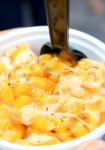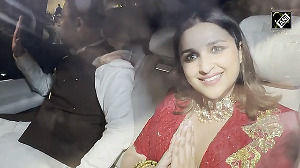This isn't a war of the sexes and "Why should guys have all the fun?" is not a slogan from the feminist brigade. It's the tagline for the TV and print campaign for Hero Honda's new offering, Pleasure.
The 102-cc gearless scooter marks the Rs 9,000-crore (Rs 90 billion) company's debut in the scooters market. But why would a company that is a market leader in motorbikes - Hero Honda commands about 50 per cent marketshare - zoom into a scooter segment that is only 14 per cent of the Rs 16-18,000 crore (Rs 160-180 billion) two-wheeler market?
"The scooters' market is a dormant one but there's huge potential there - and we mean to expand it," says a confident Pawan Munjal, managing director, Hero Honda.
Munjal's confidence is based on hard facts. Studies by the company in early 2004 revealed that for the 14.5 million households that own a Hero Honda bike, the preferred second two-wheeler is a scooter.
Besides, industry experts estimate the current growth of gearless scooters to be 18 to 20 per cent, more than the overall total two-wheeler growth of 10 to 15 per cent. "You ain't seen anything yet," quips an industry expert, forecasting the gearless scooter market will constitute 25-30 per cent of the two-wheeler market in the next couple of years.
It's easy to see why. Gearless scooters are lighter, less bulky and fuel-efficient," says Anang Dev Jena, research director, Synovate Motoresearch. Because of their streamlined looks and convenience, gearless scooters may dissuade people from buying a geared one, and for a few thousand rupees more, they may attract those who could, until now, only afford a moped.
Still, Pleasure is somewhat surprising. "The Pleasure is an off-shoot of sharing technology that wasn't expected," reveals an industry expert. After all, Hero Honda is a joint venture with Japan's Honda Motor Company, which is already present in India independently as Honda Motors and Scooters India.
In fact, HMSI, which entered the scooters market with the 102-cc gearless Activa in 2001, is already the market leader in the segment and sells nearly 28,000 units a month.
One possible explanation, according to the expert: "Honda doesn't usually sell in large numbers. If it did, the company would have to create the supporting infrastructure."
Honda could, of course, do that; but it's far easier to take advantage of Hero Honda's wide distribution network. "We believe HMSI and Hero Honda will complement each other, and not compete," says Munjal.
Hero Honda started looking seriously at scooters back in 2004, when it commissioned IMRB to study the market. "The findings were an eye-opener," says P S Sunder, head, marketing, Hero Honda. Until now, men were the obvious - and only - target group for all two-wheelers.
However, times were changing and an ever-growing, upwardly mobile base of women in the 18-25 years group was asking for two-wheelers. "But no one had specifically targeted them until now," says Sunder excitedly. "That's exactly what we decided to do."
Available in eight colours ranging from coy silver to a blazing red, the compact model offers almost all that other gearless scooters do - an ABS (plastic) body, self-start or variomatic, a 7 bhp torque like HMSI's Dio, an impressive top speed of 77 kmph... Priced at Rs 36,400 (ex-showroom, New Delhi), the scooter maintains a price parity with competition - TVS' Scooty; HMSI's Activa and Dio; Kinetic's Zoom and Nova; and Bajaj's Sunny and Saffire.
What is different, however, is the way the Pleasure is being marketed. Hero Honda has gone in for a high-decibel print and television campaign for Pleasure, conceived by FCB Ulka. The colourful images all show happy, empowered women vrooming away on the Pleasure to the theme of "Why should guys have all the fun?"
What is the most radical step by the company, however, are the 22 Just4her stores across 20 cities, designed and customised just for women. (Of course, the Pleasure is also showcased at the other 550 Hero Honda dealerships throughout India).
Apart from having an all-women staff - the company is now working on creating all-women teams of mechanics as well - the ambience adheres to one strict rule: appeal to women.
There's even a mirror in front of the scooter, pandering to the feminine instinct to check how every potential purchase looks - whether it's a stole, a shopping bag, or in this case, a scooter. "The entire showroom is an effort to make women buyers feel more at ease. Even the staff is trained to be especially warm and friendly," says Sunder.
Then there is the Lady Rider Club, a loyalty programme in line with Hero Honda's highly successful Passport Programme. Only this time, it is reserved for women. "Even if a man buys a Pleasure, he can't be a member of the Lady Rider Club," grins Munjal. Benefits will include special milestone rewards, personal accident insurance, lucky draws, invitations to special events and so on.
Synovate's Jena, however, dismisses all these tactics as mere marketing gimmicks: "These are just ways to stand out. Substantial sales will happen from the other dealer showrooms as well." He concedes the value of the exercise in brand building, but adds "Dealers may find it tough to sustain a showroom that caters to only women."
At present, though, Hero Honda's efforts seem to be bearing fruit. From the time of launch about 16 days ago, the company claims to have sold 5,000 units of Pleasure. It hopes to sell 120,000 scooters by end-2006. If Hero Honda really knows what women want, it may just get there.






 © 2025
© 2025